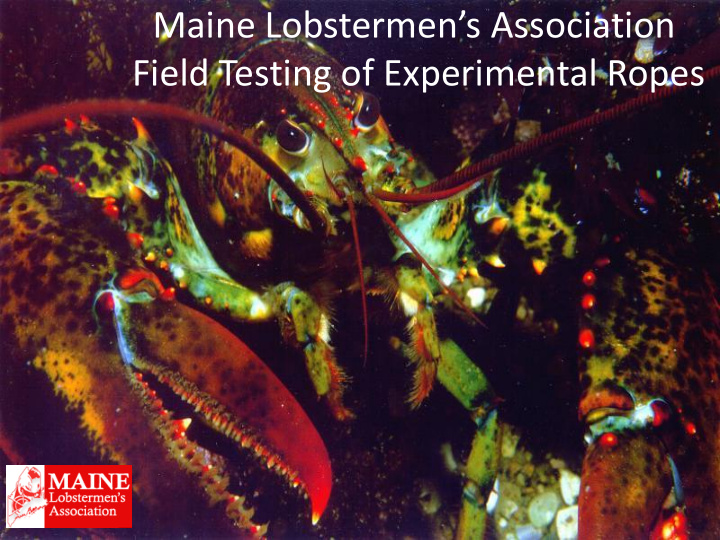



Maine Lobstermen’s Association Field Testing of Experimental Ropes
Overview of Ropes • Vertical Lines • Groundlines – glow rope – Barium sulfate sink – stiff rope – Braided metallocene sink – weak rope – DST pressure sensors – time tension line cutter
Groundline (tested 2005-2008) • Barium sulfate line (3/8”) – Build a sink line with float rope properties – Distributed ~45 coils in Maine, all regions – polypropylene line infused with BaSO 4 – deployed DST pressure sensors excellent terrible
Groundline (tested 2006-2007) • Metallocene polyethelene – inner braided polyester core with a braided metallocene polyethelene outer sheath – 3/8” (3/16” core); 7/16” (3/8” core), 1/2 ” (5/16” core) – Distributed 8 coils, all regions Metallocene Rope 5 4 3 Durability Handling 2 1 0 A C B F G
Vertical Line (tested in 2005) Glow rope (3/8”) Results • Luminescent Polypropylene • Don’t know what whales see line • Loses luminescence, likely • Recharge via UV exposure due to crushing of glow • Distributed 4 coils, all regions particles in hauler • Never observed glowing through water • Handling, noise, chaffing and fouling issues
Vertical Line (tested 2005-2008) • Weak line (3/8”, 5/16”) – polypropylene line infused with BaSO 4 – estimated breaking strength of 600-1,000 pounds – 15 coils distributed, all regions – rope parted off in downeast and midcoast sets excellent terrible
Vertical Line (fished in 2006) • Stiff rubber line – rubber sections (EPDM rubber hardness 60) clad over inner core of braided polyethylene – 3 coils distributed in Southern Maine – Handling issues (coiling, lengthening, catch in hauler) – Question of risk in baleen 2006 Evaluation of Stiff Rope 5 4 Rope A 3 Rating Rope B 2 Rope C 1 0 chafing Hang Downs Handling Fouling Noise Kinking Durability
Vertical Line (tested in 2007) • Time Tension Line Cutter – Deployed 7 units in midcoast and downeast • Issues – Operational – Safety – Scaling – Cost – Reliability
Ropes Field Test Summary • All tests very small scale as “proof of concept” – Sink rope: some positive aspects, but did not produce consistent ropes, operational issues – Glow rope: concept failed due to crushing of glow particles in hauler and fouling issues – Stiff Rope: concept failed due to handling issues and concern over interaction in baleen – Weak Rope: proved rope can be manufactured at specified breaking strength. Concept failed on hard bottom/strong tide and current areas; parting off. – TTLC: operational and unit reliability concerns
Gear Report Review
Buoy Configuration Surveys completed by interview participants
Trap Configuration Surveys completed by interview participants
What can you do to lesson your impact on whales? Common sense ideas from lobstermen • Use Less Rope – Maximize the number of traps per endline – Inside exemption line: minimize the length of floating groundline – Shorten up rope in the surface system – Limit length of vertical line to amount needed for depth/tides • Think about how a whale might get entangled – Consider your use of splices and knots. Knots weaken rope, splices may get through baleen easier. – Consider strength of rope (weaker rope on top 1/3 of buoy line) – Minimize the use of coils (shanks) on the vertical line – Investigate the use of stiff line – Best practices to minimize the chaffing of sinking line on the bottom, and against the first trap; this will reduce ghost gear
Recommend
More recommend